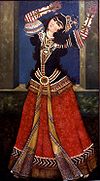Literature in Iran
| Part of a series on the |
| Culture of Iran |
|---|
 |
|
|
History
Iran's earliest surviving literary traditions are that of Avestan, the Iranic sacred language of the Avesta whose earliest literature is attested from the 6th century BC and is still preserved by the country's Zoroastrian communities in the observation of their religious rituals,[1] and that of Persian, the Iranic language that originates from the Old Iranian dialect of the region of Persis (better known as Persia) in southwestern Iran and has an earlier attested literature from between the 3rd to the 10th century AD, apart from its oldest attested form that is carved on ancient inscriptions from between the 6th to the 4th century BC.
Persian is Iran's official language and the language of the country's ethnic majority (i.e., the
Arabic literature began to develop in Iran following the Muslim conquest. The Semitic Arabic language, from which many words were borrowed into the languages of Iran and whose script replaced Iran's earlier writing systems, was used largely by Iranian authors in the medieval era, as it functioned as an international language throughout the Muslim dominance. Medieval Iranian authors used Arabic especially for scholarly literature in various fields, flourishing first through Khorasan. They wrote some of the most remarkable Arabic-language history accounts on both Iranian and universal history, notably that of the well-known scholar Tabari.[3]
The
Iran's first printing press was founded in 1633 or 1636 by Khachatur Kesaratsi, a Safavid-era Armenian archbishop from Isfahan's Armenian neighborhood of New Julfa.[10][11] Iranian Armenians, notably the 19th-century novelist Raffi, were among the contributors to Armenian literature, which originates from the earliest literary works in Armenian developed in Sasanian Armenia by the 5th century.[12] Schools dedicated especially to the Armenian communities were established since the 19th century in Azerbaijan, Isfahan, and Tehran, encouraging Armenian writing throughout modern Iran, although they were closed for a period under the reign of Reza Shah.[13]
The
Among other languages used in Iran, Lurish,[17] Balochi,[18][19] Turkmen,[20] Gilaki,[21] and Tabari[22] have also developed literature to some extent.
See also
References
- JSTOR 24651454.
- ^ Emmerick, Ronald Eric (23 February 2016). "Iranian languages". Encyclopædia Britannica. Retrieved 25 October 2018.
- ^ Danner, V. (10 August 2011). "ARABIC LANGUAGE iv. Arabic literature in Iran". Encyclopædia Iranica. Vol. II. pp. 237–243. Retrieved 26 October 2018.
- ^ "CHAGHATAY LANGUAGE AND LITERATURE". Encyclopædia Iranica. Vol. V. 13 October 2011. pp. 339–343. Retrieved 26 October 2018.
- ^ Javadi, H.; Burrill, K. (15 December 1988). "AZERBAIJAN x. Azeri Literature". Encyclopædia Iranica. Vol. III. pp. 251–255. Retrieved 26 October 2018.
- ^ Yarshater, E. (18 August 2011). "AZERBAIJAN vii. The Iranian Language of Azerbaijan". Encyclopædia Iranica. Vol. III. pp. 238–245. Retrieved 26 October 2018.
- ^ a b Kreyenbroek, Philip G. (20 July 2005). "KURDISH WRITTEN LITERATURE". Encyclopædia Iranica. Retrieved 25 October 2018.
- ^ ISBN 978-1134907663.
- ^ ISBN 978-1477311073.
- ISBN 978-0813338170.
- ISBN 978-0814332214.
- ^ Garsoian, Nina (13 April 2012). "ARMENO-IRANIAN RELATIONS in the pre-Islamic period". Encyclopædia Iranica. Retrieved 26 October 2018.
- ^ Amurian, A.; Kasheff, M. (12 August 2011). "ARMENIANS OF MODERN IRAN". Encyclopædia Iranica. Vol. II. pp. 478–483. Archived from the original on 26 October 2018. Retrieved 26 October 2018.
- ^ ISBN 978-9004346048.
- ISBN 978-3895001390.
- ^ "GORGIJANIDZE, PARSADAN". Encyclopædia Iranica (online ed.). 2016. Retrieved 26 November 2018.
- ^ Anonby, Erik J. (20 December 2012). "LORI LANGUAGE ii. Sociolinguistic Status of Lori". Encyclopædia Iranica. Retrieved 26 October 2018.
- ^ Elfenbein, J. (15 December 1988). "BALUCHISTAN iii. Baluchi Language and Literature". Encyclopædia Iranica. Vol. III. pp. 633–644. Retrieved 25 October 2018.
- ^ Dames, Mansel Longworth (1922). A Text Book of the Balochi Language. Lahore: Punjab Printing & Stationery Press. p. 3.
- ^ Knüppel, Michael (15 April 2010). "TURKMENS OF PERSIA ii. LANGUAGE". Encyclopædia Iranica. Retrieved 26 October 2018.
- ^ Stilo, Donald (9 February 2012). "GĪLĀN x. LANGUAGES". Encyclopædia Iranica. Vol. X. pp. 660–668. Retrieved 27 October 2018.
- ^ Borjian, Habib. "KOJUR ii. Language". Encyclopædia Iranica (online ed.). Retrieved 27 October 2018.
Further reading
- Melville, Charles (1993). History and Literature in Iran. I.B. Tauris. ISBN 978-1850436522.
